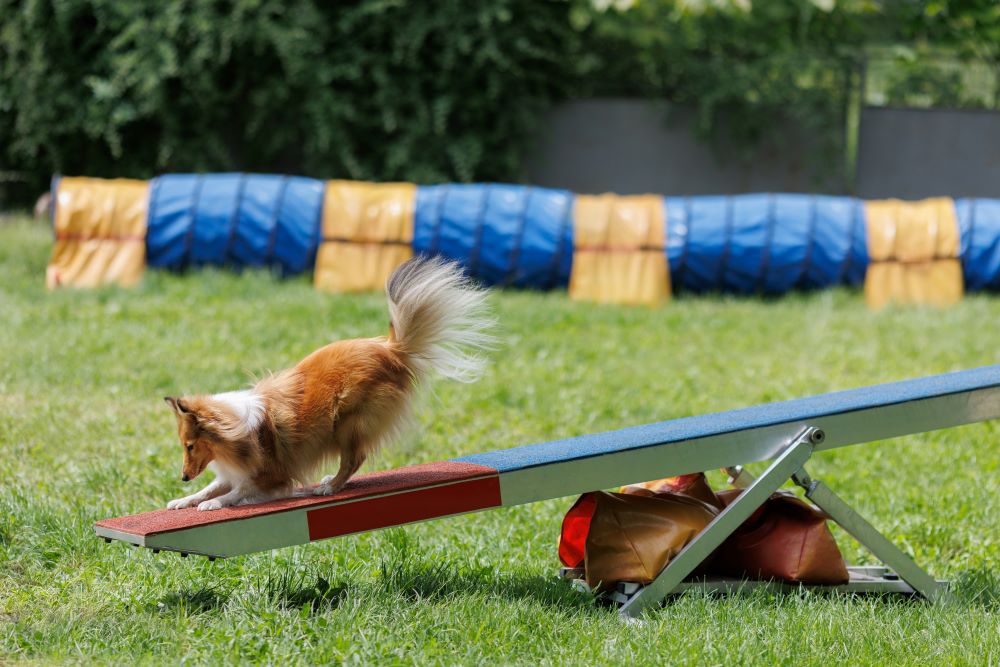
Whether you dream of entering your dog in agility competitions or you have a high-energy dog and are searching for an engaging form of exercise, dog agility can be an excellent option. While the fun factor with agility is high, safety should always be considered, and we have some helpful tips that will make using agility equipment for dogs as safe as possible.
1. Talk With Your Veterinarian
In general, agility training is safe for most healthy dogs. Dog breeds prone to breathing issues, such as pugs, might not be a great match. Some dogs with shorter legs also might not be a great match for agility, but we’ve seen our share of dachshunds zipping around the course quite happily.
We simply recommend discussing using dog agility course equipment and your dog’s health with your trusted veterinarian. Some dogs might be prone to specific types of injuries, or your vet might assess the dog’s health and determine that agility is not a good fit. In such cases, it’s best to ask your vet for exercise recommendations.
2. Begin With A Proper Warm Up
All athletes are encouraged to warm up and cool down before and after any exercise session, and this is just as essential for canine athletes. A gentle warm-up will get the blood flowing and warm up the muscles, which can prevent injuries.
You can help your dog with some warm-up stretching and perhaps head out for a short walk to get those muscles ready for training. A short walk and warm-up also expend some excess energy, which makes it easier for your dog to focus on agility jumps, weave poles and other dog obstacles.
Once your training session is over, it is important to do some cool-down exercises, as well. For instance, you can walk around the yard at a sedate pace. A bit of gentle stretching and perhaps a bit of massage also can help reduce any stiffness and give those muscles some attention.
3. Adjust Equipment To Suit A Dog’s Age & Size
One of the most important safety tips is to ensure that your agility equipment for dogs matches your dog’s age, size and breed. In agility competitions, equipment is altered for older dogs, younger dogs and smaller breeds to ensure safety.
We recommend studying the course specifications for dog agility groups such as the North American Dog Agility Council (NADAC), the American Kennel Club (AKC) or United Kennel Club (UKC) or perhaps the Teacup Dog Agility Association (K9TDAA).
At Carlson Agility, we offer a wide assortment of mini agility equipment, which is perfect for small breeds. This includes mini jumps, a mini agility a-frame and mini versions of the agility dog walk, the pause table and a mini dog agility teeter.
4. Avoid Overtraining
Unlike human athletes who can handle an hour or more of working out, dogs are better suited to shorter training sessions, typically 15-20 minutes at most. Not only is this safer for their furry bodies, but it also makes training more effective. Dogs have short attention spans, so they really cannot handle long training sessions mentally. You will find that agility training is easier, faster and safer if you stick with short training sessions.
5. Stay Hydrated
This is good advice for trainers and agility dogs! Always keep a water dish nearby for your sweet pooch so that he or she can hydrate and keep cool. Staying hydrated helps to regulate your dog’s body temperature and keep their joints lubricated. Dogs don’t cool down easily, and only perspire through their paws, and keeping hydrated can prevent overheating and heatstroke.
If the temperature in your area is above about 75 degrees, it is especially important to provide water breaks and keep training sessions very short. For summertime training or training in hot climates, we recommend training in the early morning, when the temperatures are lower, and the sun is lower in the sky. If you have a cool or air-conditioned basement, you also could lay down some mats and do some agility training indoors during the hottest times of the year.
6. Train Yourself
We believe that anyone can become a competent agility handler, but it does take some time to research the best training techniques to ensure safety. Handlers should learn the correct techniques for guiding their dogs through courses to avoid causing stress or injury to their dog.
Joining an agility club can be a good option to consider when you are just getting started, but there are many videos on YouTube and other sites that can provide you with training tips. Keep in mind that every dog is different and what works with one dog might not work with another. Customize your training methods to suit your dog’s individual needs, strengths and weaknesses.
7. Use High-Quality Dog Agility Equipment
While purchasing cheap agility equipment might seem cost-effective, it’s not the safest option. Sturdy, well-made equipment is built to handle many years of agility training and built to keep your dogs steady and safe.
In the final analysis, purchasing quality dog agility course equipment will not only increase safety but also will last for many years, which can save money in the long run. Our agility equipment for dogs is all handmade using the highest-quality components available. Our dog agility course equipment is built to the standards required by NADAC agility, AKC agility, UKC agility and other top agility organizations.
Get Started With Agility Today!Agility is a fantastic source of exercise for your dog and can improve the bond between a dog and their human companions. If you are in the market for dog agility course equipment, we have everything you need here at Carlson Agility from a quality dog tunnel to dog weave poles, tire jumps, a dog agility teeter and much more, including handy training tools and helpful dog agility starter kits. If you have questions about any of our agility equipment for dogs, please contact us at any time.





